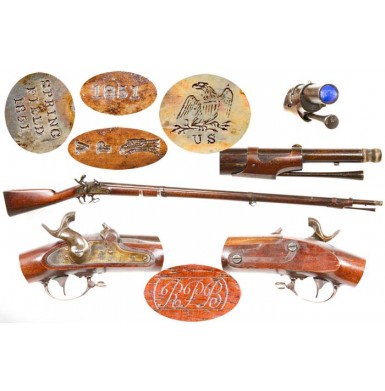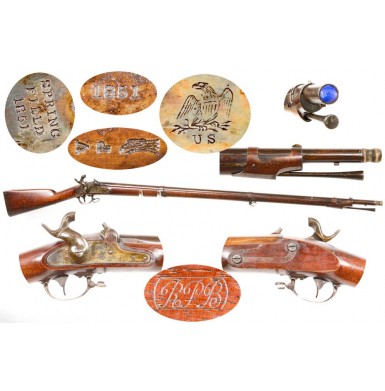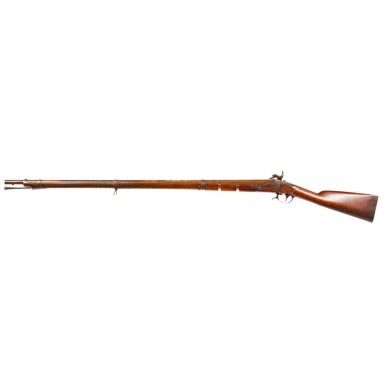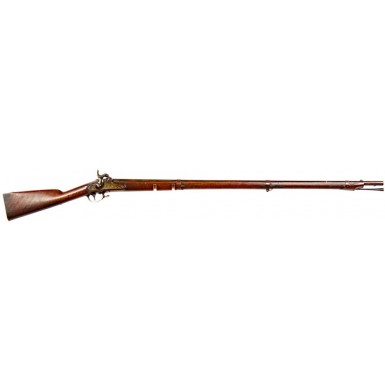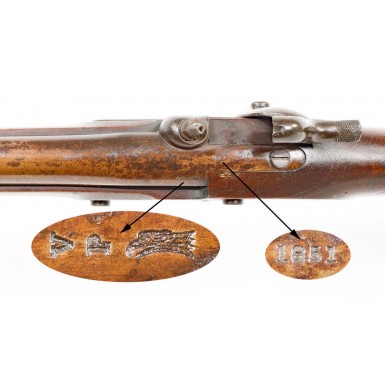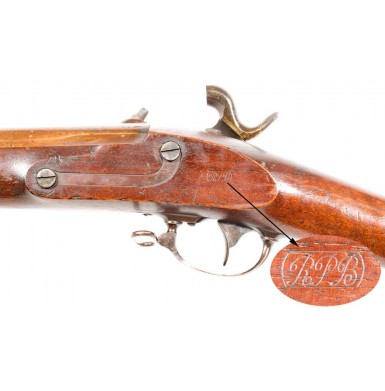Browned US M1851 Cadet Musket Dated 1851
- Product Code: FLA-3498-SOLD
- Availability: Out Of Stock
-
$1.00
In May of 1851, the United States Ordnance Department authorized the manufacture of 2,000 percussion cadet muskets. The production of these muskets was necessary to supply various state military academies with arms under the Militia Act of 1808. The supplies of Model 1841 Cadet Muskets, which had been produced at Springfield between 1844 and 1846, had all been issued to the Military Academy at West Point, and only full sized percussion conversion muskets were available for issue to the states. These guns were considered too large and heavy for cadet use, and this resulted in the authorization to manufacture new cadet muskets at Springfield. The M1851 Cadet Musket was quite similar to the preceding M1841 Cadet Musket, both being .57 caliber smoothbore percussion muzzle loaders that were essentially scaled-down versions of the standard issue US infantry musket, the Model 1842. Much of the pressure to approve these new muskets came from the state of Virginia, which had been trying to secure percussion cadet muskets for almost a decade. The state had been consistently told that once the supply needed for West Point was produced that any additional muskets would be sent to Virginia for the use of the cadets at The Virginia Military Institute (VMI). This never occurred, so it is not surprising that President Zachary Taylor, a Virginia native, ordered that the initial production of Model 1851 Cadet Muskets be sent to VMI. A total of 4,000 of the M1851 Cadet Muskets were produced between 1851 and 1853. Springfield production records indicate that 2,000 were completed and received into stores in fiscal year 1852 (July 1, 1851 through June 30, 1852) and an additional 2,000 were completed in fiscal year 1853 (July 1, 1852 through June 30, 1853). Of the 4,000 Cadet Musket produced, the first 300 were sent to VMI by order of President Zachary Taylor. These guns were shipped on May 5, 1852. Due to the fiscal year accounting system these guns were listed as having been “manufactured” in 1852, but the gunlocks and barrels were dated based upon the calendar year, 1851. This explains why all of the concretely identified examples of VMI issued M1851 Cadet Muskets are dated 1851. An additional group of 200 M1851 Cadet Muskets were shipped to Virginia on August 4 of 1852; these appear to be sent to VMI as well. George Moller notes in American Military Shoulder Arms Volume III that an 1858 inventory of muskets at VMI listed 300 browned M1851s and 200 bright M1851s. Thus, it is reasonable to assume that the first 300 US M1851 Cadet Muskets were manufactured with the National Armory Brown finish. This is quite understandable, as the preceding US M1841 Cadet Musket had been produced with a browned barrel and furniture, color casehardened lock and hammer and bright ramrod. At Springfield, the authorization of the new M1851 was essentially the continuation of the old M1841 Cadet Musket program.
It is interesting that the both the M1841 and earliest M1851 Cadet Muskets were produced with the National Armory Brown finish. This finish had been abandoned in the early 1830s for muskets due to problems with the muskets literally rusting in the racks. The Ordnance Department discovered that the guns with this finish needed to cure for some time with air circulating around them before being crated for storage, which created numerous problems. Not the least of which was the space to store these muskets in racks, as well as the need to tend to them to prevent them from rusting while curing. As such, it was deemed easier to maintain bright muskets than browned muskets, and this finish was abandoned for muskets, although it was retained for rifles and some carbines. After the production of the first 300 US M1851 Cadet Muskets, the issues with the finish probably became apparent again, so the remainder of the guns were finished National Armory Bright. It seems reasonable that VMI found it extremely difficult to maintain the browned finish on the guns, which is why browned examples are practically never found for sale. Much like the browned US M1822 muskets, over the years even those that did not “rust in the racks’ often ended up being struck bright simply by simple maintenance and cleaning over time.
Several other southern states received US Model 1851 Cadet Muskets during 1852, all of which appear to have been National Armory Bright. These states included: Alabama (245), Georgia (235), Kentucky (225), Mississippi (150), North Carolina (65), South Carolina (100) and Tennessee (80). In 1856, Virginia received 10 more US M1851 Cadet Muskets, and the state of New York received a total of 1,150 of the guns, with 150 shipping in 1855 and 1,000 in 1857. Up to this point none of the M1851 Cadet Muskets were issued to the US Military Academy at West Point. It was determined that since there was not a substantial change or improvement between the M1841 Cadet Musket then in use by the cadets and the new M1851, there was no reason replace the M1841 Cadet Muskets in service at West Point. This changed in 1855, with the official adoption of the Model 1855 Rifle Musket and the subsequent family of M1855 rifled arms for issue to the US military. It was determined that the cadets at West Point needed to have experience and knowledge about the new rifled and sighted arms that were to become standard issue, and in 1856 300 of the M1851 Cadet Muskets in storage at Springfield were altered from smoothbore to rifled arms and had long range rear sights installed. An additional 14 were so altered the following year, with 9 more were altered in 1858, for a total of 323 M1851 Cadet Muskets being modified by rifling and sighting muskets. These guns were issued to the Corps of Cadets at West Point and were the first rifled arms to be used at a US military academy.
As originally produced, the US Model 1851 Cadet Musket was a single shot, muzzle loading, percussion musket in .57 caliber that was essentially a scaled down version of the musket that was in current service, the M1842. The musket was slightly smaller throughout, when compared to the M1842. The round barrel was 40” instead of 42”, and the lock was from the smaller M1847 family of percussion carbines, and not a full sized musket lock; the earlier M1841 Cadet Muskets had used locks of the size and configuration used on M1841 Mississippi Rifles. The stock was also proportionally reduced in overall size compared to the M1842 musket, and this is most visible in the smaller buttstock and much slimmer wrist. As previously mentioned, the guns were produced in .57 caliber instead of .69 caliber. When the M1851s were altered for use at West Point, they were rifled with 3 grooves, and had M1855 pattern long range sights installed. The rifling was .2” wide and was of progressive depth, being .015” deep at the breech end of the barrel and .005” deep at the muzzle. The rate of twist was a slow 1 turn in 72”, with a right hand twist. The M1855 long-range sight was attached to the barrel with a dovetail notch for the rear portion of the base and a single spanner screw that secured the front portion of the base. A new, taller, iron front sight blade was soldered and riveted to the front strap of the upper barrel band, replacing the original brass blade front sight that was used on the smoothbore version of the musket. The trumpet shaped ramrod was also modified from its original configuration by machining a concave recess at its tip. This was to accept the newly adopted Burton designed, Mini” style conical ammunition. It is generally believed that all 323 of the Rifled & Sighted M1851 Cadet Muskets were issued to West Point, although it is possible that only the first 300 were. The West Point issued M1851 Cadet Muskets are typically rack numbered on their buttplate tang and usually have an additional inventory number on the top of the lower barrel band.
This US Model 1851 Cadet Musket (Flayderman 9A-304) is in about FINE condition and is one of the very scarce National Armory Brown examples. With only 7.5% of the total output of US M1851 Cadet Muskets being browned, the gun is very rarely encountered with this finish. Of those 300 guns, it appears that no more than a handful survive with the original brown and casehardened finish, as the guns often ended up being struck bright during the decade or so that they spent in service. The gun retains about 20%-30% of the original arsenal brown finish, with the distinctive reddish tone of the “dragon’s blood” component in the formula. The gun also shows exactly why browning was generally considered a suitable finish for muskets, as there are numerous scattered patches of surface oxidation and evidence of “rusting in the rack”. The musket remains very crisp, with well-marked metal and a fine cartouche on the stock. The lock of the musket retains about 85%+ of its vivid color casehardened finish with the hammer having faded significantly, only retaining about 30%. The lock is very clearly marked behind the hammer in three vertical lines: SPRING / FIELD / 1851 and is marked with a spread-winged (EAGLE) / US forward of the hammer. The tang is crisply marked with the matching date 1851 as well. The upper left quadrant of the breech is crisply marked with the usual Springfield Arsenal V / P / (EAGLE HEAD) view, proof and inspection marks. The upper tang of the buttplate is marked with the usual US. The stock flat bears a very crisp and clear RPB script cartouche in a box with rounded corners. This is the mark of Springfield Arsenal inspector Robert P. Beals. While Beals’ cartouches are more often encountered on Civil War era contract arms, the same pattern of cartouche as found on this musket is also found on US M1847 musketoons produced during the early 1850s. Beals only worked inside Springfield from mid-1850 until August of 1852, when he departed to work for the Whitneyville Armory. Beals did return to work as a contract inspector during the Civil War, circa 1862 and remained in that position through the early 1870s.
The lock functions crisply and correctly on all positions and is in mechanically excellent condition. The original cone (nipple) is in place in the bolster and is in crisp condition, some traces of its original blued finish, which has dulled and faded from use and age. As noted, the iron barrel and furniture retain about 20%-30% of their faded and thinned National Armory Brown finish, with some areas retaining rich reddish brown color and others only thin wisps of brown. The faded and thinned finish has mixed with a brownish oxidized patina and the metal shows the aforementioned patches of surface oxidation, some surface roughness and even some areas of light pitting. This is most noticeable at the breech and bolster area and near the muzzle and ramrod tip. There are some scattered flecks of oxidized surface roughness here and there on the lock as well. The bore of the musket is in about FINE overall condition. The smooth bore is mostly bright with some frosting and some scattered areas of oxidized darkness, most of which is found in the last few inches nearest the muzzle. The bore would probably be further improved with a good scrubbing but looks as if it would shoot well in its current condition. The correct, original brass blade front sight is in place on the front strap of the upper barrel band. The original full-length ramrod is in place in the channel under the barrel and retains fine threads on the opposite end. The trumpet tip is in its correct and original convex configuration. Both original sling swivels remain on the musket, with the upper one on the middle barrel band and the lower one on the forward portion of the triggerguard bow. Both swivels are slightly bent. The stock is in about VERY FINE condition overall and retains excellent edges and sharp lines throughout. The stock is solid and is free of any breaks or repairs and there is no indication that the stock was ever sanded. The stock has a very attractive reddish-brown tone to it. The stock does show the expected scattering of minor bumps, dings, nicks and scuffs from use and storage but shows absolutely no abuse. There are also some minor small nicks in the wood along the edges of the ramrod channel, which is quite common with muzzle loading military muskets. As noted the stock flat retains an outstanding inspection cartouche. Included with the musket is an original and correct wooden .57 caliber tompion that is a scaled down version of that used with the US M1842 and the latter M1855-M1864 pattern arms. These rare tompions often sell for $100 or more on their own and are a wonderful accessory to have included with the gun.
Overall, this is a really attractive, fine condition example of an extremely rare and desirable 1851 Dated National Armory Brown US M1851 Cadet Musket. The matching 1851 dates and browned finish almost certainly guarantee that this gun was initially sent to Virginia for use by the cadets at VMI. As such, it is a secondary Confederate musket as nearly all of the VMI inventory of arms eventually found their way on to the battlefields of Virginia, often in the hands of VMI Cadets. Over the last two decades I think I have seen less than five browned examples of US M1851 Cadet Muskets and I cannot remember the last one that I saw for sale at a show or on a dealer’s web site. This is a very special, historically important gun that belongs in a very advanced collection of Civil War era long arms or would be an ultimate addition to a collection of US Cadet Muskets. You may not have another opportunity to obtain a browned M1851 with this much case color on the lock and such a fine cartouche in the next decade. This is one of those special guns that will disappear into an advanced collection and may not come out again in my lifetime.
SOLD
